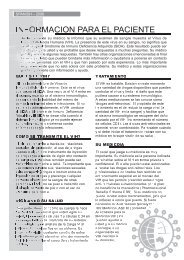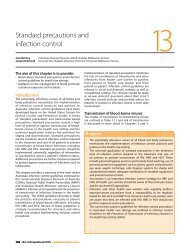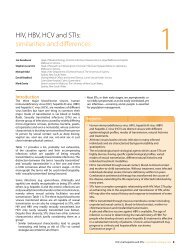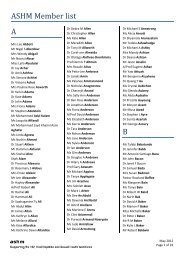B Positive – all you wanted to know about - ASHM
B Positive – all you wanted to know about - ASHM
B Positive – all you wanted to know about - ASHM
Create successful ePaper yourself
Turn your PDF publications into a flip-book with our unique Google optimized e-Paper software.
5 Primary prevention of hepatitis B virus infection<br />
Vaccines available<br />
1. Monovalent vaccines<br />
Hepatitis b<br />
surface antigen<br />
(Hbsag)<br />
engerix-b (adult formulation) 20 µg per 1 mL<br />
engerix-b (paediatric<br />
formulation)<br />
10 µg per 0.5<br />
mL<br />
H-b-VaX ii (adult formulation) 10 µg per 1 mL<br />
H-b-VaX ii (paediatric<br />
formulation)<br />
H-b-VaX ii (dialysis<br />
formulation)<br />
5 µg per 0.5 mL<br />
40 µg per 1 mL<br />
2. Combination vaccines<br />
a) combination vaccines that include both<br />
diphtheria, tetanus, acellular pertussis (dtPa)<br />
and hepatitis b<br />
� Infanrix HepB: diphtheria-tetanus-acellular<br />
pertussis-hepatitis b (GlaxosmithKline)<br />
� Infanrix Hexa: diphtheria-tetanus-acellular<br />
pertussis-hepatitis b-inactivated poliomyelitis<br />
vaccine-Haemophilus influenzae type b<br />
(GlaxosmithKline)<br />
� Infanrix Penta: diphtheria-tetanusacellular<br />
pertussis-hepatitis b-inactivated<br />
poliomyelitis vaccine (GlaxosmithKline).<br />
b) other combination vaccines that include<br />
hepatitis b:<br />
� Comvax: Haemophilus influenzae type b<br />
<strong>–</strong> hepatitis b (csL biotherapies; Merck & co<br />
inc.)<br />
� Twinrix Junior (360/10): combined hepatitis<br />
a virus (HM175 strain) and recombinant<br />
hepatitis b vaccine (GlaxosmithKline)<br />
� Twinrix (720/20): hepatitis a virus (HM175<br />
strain) and recombinant hepatitis b vaccine<br />
(GlaxosmithKline).<br />
Current National Immunisation<br />
Program: 2007<br />
Infants<br />
<strong>all</strong> infants are recommended <strong>to</strong> receive<br />
hepatitis b vaccine within eight days of birth,<br />
followed by three further doses in infancy<br />
(table 5.2). the type of HbV vaccine used differs<br />
between states and terri<strong>to</strong>ries.<br />
48 b <strong>Positive</strong> <strong>–</strong> <strong>all</strong> <strong>you</strong> <strong>wanted</strong> <strong>to</strong> <strong>know</strong> <strong>about</strong> hepatitis b: a guide for primary care providers<br />
table 5.2: the national immunisation Program<br />
for Hepatitis b 11<br />
age antigen<br />
nsW, act,<br />
Wa, tas<br />
Vic, QLd,<br />
sa<br />
birth Hep b monovalent monovalent monovalent<br />
2 mth Hep b<br />
4 mth Hep b<br />
6 mth Hep b<br />
dtPa-HibiPV-<br />
Hep b<br />
dtPa-HibiPV-<br />
Hep b<br />
dtPa-HibiPV-<br />
Hep b<br />
Hib-Hep b<br />
Hib-Hep b<br />
12 mth Hep b Hib- Hep b<br />
dtPa: diphtheria-tetanus-acellular pertussis<br />
Hib: Haemophilus influenzae type b<br />
iPV: oral inactivated poliomyelitis vaccine<br />
nt<br />
dtPa- iPV-<br />
Hep b<br />
dtPa- iPV-<br />
Hep b<br />
dtPa-<br />
iPV- Hep b<br />
Premature infants<br />
Preterm babies do not respond as well <strong>to</strong> the<br />
hepatitis b vaccine as term babies. 7 for babies<br />
under 32 weeks gestation or less than 2000g<br />
birth weight, it is recommended <strong>to</strong> give the<br />
vaccine at 0, 2, 4 and 6 months of age and<br />
either:<br />
(a) measure anti-Hbs at 7 months of age<br />
and give a booster at 12 months of age if<br />
antibody titre is less than 10 miu/mL, or<br />
(b) give a booster at 12 months of age without<br />
measuring the antibody titre. 11<br />
Adolescents<br />
adolescents not vaccinated in childhood<br />
are recommended <strong>to</strong> receive the hepatitis b<br />
vaccine. two regimens are available:<br />
� three-dose regimen for adolescents aged<br />
up <strong>to</strong> 20 years: Hepatitis b (paediatric<br />
formulation): 3 doses of 0.5 mL. the optimal<br />
interval is one month between first and<br />
second dose and a third dose given five<br />
months after the second dose.<br />
� two-dose regimen for adolescents aged 11 <strong>to</strong><br />
15 years: H-b-Vax ii 10 µg (adult formulation)<br />
or engerix-b 20 µg (adult formulation) at 0<br />
and 4<strong>–</strong>6 months.<br />
Accelerated vaccination schedules<br />
two products, engerix-b (adult) and twinrix<br />
(720/20), are registered for use in accelerated<br />
schedules. accelerated schedules should only<br />
be used if there is very limited time before<br />
departure <strong>to</strong> endemic regions (table 5.3).






